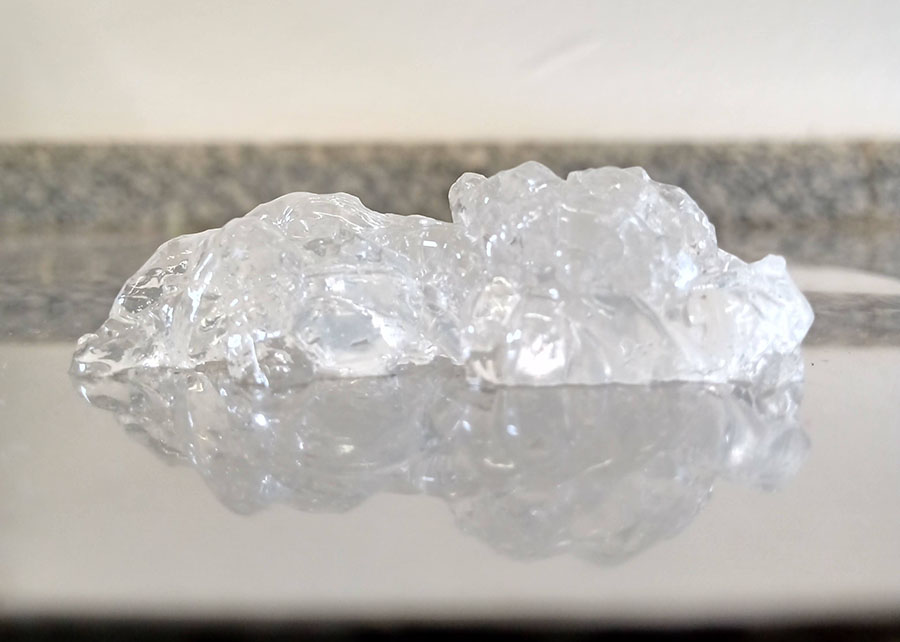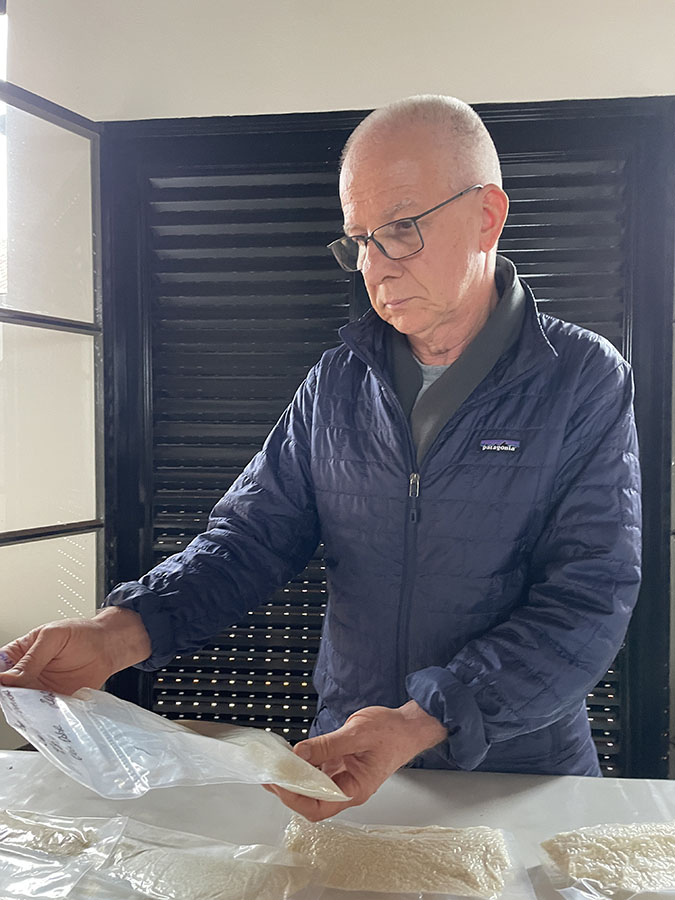The production uses the skin, which would be discarded or sent to animal feed industry. Advance adds value and reduces fish processing waste. The fish skin gelatin may produce films, microcapsules for medicine, and food thickeners. Gelatin from tambaqui is an alternative to porcine and bovine ones. Embrapa researchers found an alternative to replace the conventional gelatin made from pigskin and cowhide: gelatin from tambaqui (Colossoma macropomum), a Brazilian native fish that is highly economically important. Tambaqui skins, scales and heads are usually used to produce fish feed. However, gelatin produced from those items can be used for food and pharmaceutical applications, that is, it becomes a co-product with higher added value. Its properties point to use in a range of applications, including films, microcapsules for drugs, food thickeners, etc. The initiative can also contribute to reducing waste. Growth in fish farming Fish production in Brazil has substantially grown and improved its processing. Embrapa has carried out research within the BRS Aqua project to improve and expand the chain. According to the Brazilian Fish Farming Association Yearbook (Peixe BR) 2022, domestic fish production has increased 45% since 2014. Tilapia corresponds to 65% of the production, whereas tambaqui is the leader of native fishes, with 30% of the total production. The project "Structuring Actions and Innovation to Strengthen Aquaculture Production Chains in Brazil" (BRS Aqua) is supported by the Brazilian Development Bank (BNDES), National Council for Scientific and Technological Development (CNPq), and the Department of Agriculture and Fishery of the Ministry of Fisheries and Aquaculture (MPA). Embrapa Fisheries & Aquaculture coordinates the BRS Aqua network, which counts on not only 240 Embrapa employees from 23 branches of the corporation, but also 60 partners from both the public and private sector. According to Manuel Antônio Jacintho (on the right), a researcher at Embrapa Southeast Livestock, depending on the species and type of product, up to 50% of the initial raw material is discarded, including heads, carcasses, skin, and scales. “Transforming waste into valuable products makes the chain more sustainable”, Jacintho highlights. The researcher says that there is a great diversity of Brazilian native fish species for human consumption. Consequently, there is potential to explore the technologicsl properties of the waste from the fishing chain. Tambaqui is the most produced Brazilian native fish in the country. “It is important to show its advantages against other fish, show that the gelatin from tambaqui skin has technological characteristics that can replace bovine and porcine gelatin. Its amino acid composition is richer than that of cold-water fish. Gel strength (consistency) can be compared to bovine and porcine ones”, explains Fernanda Ramalho Procópio, a CNPq postdoctoral fellow at the time of the study. Various factors interfere in the composition of fish skin, such as species, age, sex, and kind of feed. The protein content can influence the production of gelatin extraction and the amino acid composition. In addition, high fat content makes it difficult to obtain an odorless and translucent product, which is important in consumer perception. In that sense, tambaqui presents advantages because its skin has a higher protein content (27,10 ± 0,02) and a lower fat content (1,17 ± 0,08) than other species. That results in a yield of of almost 60% in skin gelatin extraction. The main amino acids found were: glycine, proline, and hydroxyproline, which are responsible for skin firmness. Quality gelatin The gelatin made of tambaqui skin presents characteristics that meet conventional product standards. The extraction yield was of 53% (based on dry initial skin), adequate gelling strengh (medium Bloom strength), low turbidity and significant levels of amino acids, which influence gel strength. According to Adriano Mattos, a supervisor at Embrapa Tropical Agroindustry's Biomass Technology Laboratory, the gelling temperature observed (16 °C) is compatible with the one of the commercial bovine gelatin (17 °C). The thermal behavior of tambaqui skin gelatin was investigated using differential scanning calorimetry. He adds that the temperature at which degradation begins, around 105 °C, favors its potential application in the development of new materials in the food and pharmaceutical industries. Gel strength (consistency) was of 123 ± 20 gramas, which classifies it as medium Bloom. Commercial gelatin is usually classified based on high (200-300 grams), medium (100-200 grams) and low (50-100 grams) Bloom values. The whitish color, the lack of odor and lack of turbidity are characteristics within the commercial requirements for gelatin. Photo by: Fernanda Ramalho Procópio Potential Due to its medium Bloom, tambaqui skin gelatin could be appropriate for certain products, to clarify beverages, and to produce soft capsules. The higher amino acid content, compared to other fish species, suggests that tambaqui skin could be used as a valuable source of collagen peptides. According to Fernanda Procópio, although it was not the focus of the study, several investigations have shown the potential of using fishery waste as a source of bioactive peptides. “Exploring applications and strategies to use tambaqui processing waste can increase the farmer's income and reduce the environmental impact associated with waste disposal”, Manuel Jacintho explains. The characteristics of the gelatin make it a promising material to produce microparticles, films, and hydrogels. A sequence to the study is already in progress, investigating the potential use of the material in the production of films as food packaging components. Paper The study was published by the Journal of Aquatic Food Product Technology (2024, vol. 33), with the title "An Enhancement to Development, Characterization and Potential Application of Gelatin Extracted from Native Brazilian Fish Skin".
Photo: Fernanda Ramalho Procópio

Fish gelatin as gel
Embrapa researchers found an alternative to replace the conventional gelatin made from pigskin and cowhide: gelatin from tambaqui (Colossoma macropomum), a Brazilian native fish that is highly economically important.
Tambaqui skins, scales and heads are usually used to produce fish feed. However, gelatin produced from those items can be used for food and pharmaceutical applications, that is, it becomes a co-product with higher added value. Its properties point to use in a range of applications, including films, microcapsules for drugs, food thickeners, etc. The initiative can also contribute to reducing waste.
Growth in fish farming Fish production in Brazil has substantially grown and improved its processing. Embrapa has carried out research within the BRS Aqua project to improve and expand the chain. According to the Brazilian Fish Farming Association Yearbook (Peixe BR) 2022, domestic fish production has increased 45% since 2014. Tilapia corresponds to 65% of the production, whereas tambaqui is the leader of native fishes, with 30% of the total production. The project "Structuring Actions and Innovation to Strengthen Aquaculture Production Chains in Brazil" (BRS Aqua) is supported by the Brazilian Development Bank (BNDES), National Council for Scientific and Technological Development (CNPq), and the Department of Agriculture and Fishery of the Ministry of Fisheries and Aquaculture (MPA). Embrapa Fisheries & Aquaculture coordinates the BRS Aqua network, which counts on not only 240 Embrapa employees from 23 branches of the corporation, but also 60 partners from both the public and private sector. |
 According to Manuel Antônio Jacintho (on the right), a researcher at Embrapa Southeast Livestock, depending on the species and type of product, up to 50% of the initial raw material is discarded, including heads, carcasses, skin, and scales. “Transforming waste into valuable products makes the chain more sustainable”, Jacintho highlights.
According to Manuel Antônio Jacintho (on the right), a researcher at Embrapa Southeast Livestock, depending on the species and type of product, up to 50% of the initial raw material is discarded, including heads, carcasses, skin, and scales. “Transforming waste into valuable products makes the chain more sustainable”, Jacintho highlights.
The researcher says that there is a great diversity of Brazilian native fish species for human consumption. Consequently, there is potential to explore the technologicsl properties of the waste from the fishing chain.
Tambaqui is the most produced Brazilian native fish in the country. “It is important to show its advantages against other fish, show that the gelatin from tambaqui skin has technological characteristics that can replace bovine and porcine gelatin. Its amino acid composition is richer than that of cold-water fish. Gel strength (consistency) can be compared to bovine and porcine ones”, explains Fernanda Ramalho Procópio, a CNPq postdoctoral fellow at the time of the study.
Various factors interfere in the composition of fish skin, such as species, age, sex, and kind of feed. The protein content can influence the production of gelatin extraction and the amino acid composition. In addition, high fat content makes it difficult to obtain an odorless and translucent product, which is important in consumer perception.
In that sense, tambaqui presents advantages because its skin has a higher protein content (27,10 ± 0,02) and a lower fat content (1,17 ± 0,08) than other species. That results in a yield of of almost 60% in skin gelatin extraction. The main amino acids found were: glycine, proline, and hydroxyproline, which are responsible for skin firmness.
 Quality gelatin Quality gelatin
The gelatin made of tambaqui skin presents characteristics that meet conventional product standards. The extraction yield was of 53% (based on dry initial skin), adequate gelling strengh (medium Bloom strength), low turbidity and significant levels of amino acids, which influence gel strength. According to Adriano Mattos, a supervisor at Embrapa Tropical Agroindustry's Biomass Technology Laboratory, the gelling temperature observed (16 °C) is compatible with the one of the commercial bovine gelatin (17 °C). The thermal behavior of tambaqui skin gelatin was investigated using differential scanning calorimetry. He adds that the temperature at which degradation begins, around 105 °C, favors its potential application in the development of new materials in the food and pharmaceutical industries. Gel strength (consistency) was of 123 ± 20 gramas, which classifies it as medium Bloom. Commercial gelatin is usually classified based on high (200-300 grams), medium (100-200 grams) and low (50-100 grams) Bloom values. The whitish color, the lack of odor and lack of turbidity are characteristics within the commercial requirements for gelatin. Photo by: Fernanda Ramalho Procópio |
Potential
Due to its medium Bloom, tambaqui skin gelatin could be appropriate for certain products, to clarify beverages, and to produce soft capsules.
The higher amino acid content, compared to other fish species, suggests that tambaqui skin could be used as a valuable source of collagen peptides. According to Fernanda Procópio, although it was not the focus of the study, several investigations have shown the potential of using fishery waste as a source of bioactive peptides.
“Exploring applications and strategies to use tambaqui processing waste can increase the farmer's income and reduce the environmental impact associated with waste disposal”, Manuel Jacintho explains.
The characteristics of the gelatin make it a promising material to produce microparticles, films, and hydrogels. A sequence to the study is already in progress, investigating the potential use of the material in the production of films as food packaging components.

Gisele Rosso (MTb 3.091/PR)
Embrapa Southeast Livestock
Press inquiries
pecuaria-sudeste.imprensa@embrapa.br
Phone number: +55 16 98190-9090
Verônica Freire (MTb 01.225/JP)
Embrapa Tropical Agroindustry
Press inquiries
agroindustria-tropical.imprensa@embrapa.br
Phone number: +55 85 3391-7116
Ana Lucia Ferreira (MTb 16.913/RJ)
Embrapa Food Technology
Translation: Ana Maranhão
Embrapa's Superintendency of Communications
Further information on the topic
Citizen Attention Service (SAC)
www.embrapa.br/contact-us/sac/
 According to Manuel Antônio Jacintho (on the right), a researcher at Embrapa Southeast Livestock, depending on the species and type of product, up to 50% of the initial raw material is discarded, including heads, carcasses, skin, and scales. “Transforming waste into valuable products makes the chain more sustainable”, Jacintho highlights.
According to Manuel Antônio Jacintho (on the right), a researcher at Embrapa Southeast Livestock, depending on the species and type of product, up to 50% of the initial raw material is discarded, including heads, carcasses, skin, and scales. “Transforming waste into valuable products makes the chain more sustainable”, Jacintho highlights. 


